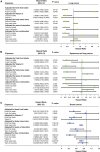Association between dried fruit intake and pan-cancers incidence risk: A two-sample Mendelian randomization study
- PMID: 35923199
- PMCID: PMC9339715
- DOI: 10.3389/fnut.2022.899137
Association between dried fruit intake and pan-cancers incidence risk: A two-sample Mendelian randomization study
Abstract
Background: Observational studies have revealed that dried fruit intake may be associated with cancer incidence; however, confounding factors make the results prone to be disturbed. Therefore, we conducted a two-sample Mendelian randomization (MR) study to explore the causal relationship between dried fruit intake and 11 site-specific cancers.
Materials and methods: Forty-three single nucleoside polymers (SNPs) with robust genome-wide association study (GWAS) evidence, strongly correlated with dried fruit intake, were used as instrumental variables (IVs) in this study. The summary-level genetic datasets of site-specific cancers were obtained from the Oncoarray oral cavity and oropharyngeal cancer consortium, International Lung Cancer Consortium, Breast Cancer Association Consortium (BCAC), Ovarian Cancer Association Consortium, PanScan1, and GWAS of other scholars. We analyzed the causality between dried fruit intake and 11 site-specific cancers using the inverse-variance-weighted (IVW) and weighted median (WM) methods. For the results of the MR analysis, Cochran's Q test was used to check for heterogeneity, and multiplicative random effects were used to evaluate the heterogeneity further. Gene pleiotropy was tested using MR-Egger regression and MR-PRESSO methods. In addition, the main results of this study were validated by using the summary statistical data from the FinnGen and UK Biobank databases, and adjusted body mass index (BMI), years of education, fresh fruit intake, and vitamin C using multivariable MR analysis to ensure the stability of the research results.
Results: The evidence from IVW analyses showed that each increase of dried fruit intake by one standard deviation was statistically significantly associated with 82.68% decrease of oral cavity/pharyngeal cancer incidence risk (P = 0.0131), 67.01% decrease of lung cancer incidence risk (P = 0.0011), 77% decrease of squamous cell lung cancer incidence risk (P = 0.0026), 53.07% decrease of breast cancer incidence risk (P = 4.62 × 10-5), 39.72% decrease of ovarian cancer incidence risk (P = 0.0183), 97.26% decrease of pancreatic cancer incidence risk (P = 0.0280), 0.53% decrease of cervical cancer incidence risk (P = 0.0482); however, there was no significant effect on lung adenocarcinoma (P = 0.4343), endometrial cancer (P = 0.8742), thyroid cancer (P = 0.6352), prostate cancer (P = 0.5354), bladder cancer (P = 0.8996), and brain cancer (P = 0.8164). In the validation part of the study results, the causal relationship between dried fruit intake and lung cancer (P = 0.0043), squamous cell lung cancer (P = 0.0136), and breast cancer (P = 0.0192) was determined. After adjusting for the potential impact of confounders, the causal relationship between dried fruit intake and lung cancer (P = 0.0034), squamous cell lung cancer (P = 0.046), and breast cancer (P = 0.0001) remained. The sensitivity analysis showed that our results were stable and reliable.
Conclusion: The intake of dried fruits may have a protective effect against some site-specific cancers. Therefore, health education and a reasonable adjustment of dietary proportions may help in the primary prevention of cancer.
Keywords: Mendelian randomization; causal relationship; dried fruit intake; incidence risk; site-specific cancers.
Copyright © 2022 Jin, Li, Deng, Lin, Li, Yang, Su, Wang, Yang, Wang, Chen and Wang.
Conflict of interest statement
The authors declare that the research was conducted in the absence of any commercial or financial relationships that could be construed as a potential conflict of interest.
Figures





Similar articles
-
The association between fruit and vegetable intake and gastrointestinal cancers risk from Mendelian randomization analysis.Sci Rep. 2024 Nov 21;14(1):28860. doi: 10.1038/s41598-024-79650-2. Sci Rep. 2024. PMID: 39572657 Free PMC article.
-
Association between Dried Fruit Intake and DNA Methylation: A Multivariable Mendelian Randomization Analysis.J Nutr Health Aging. 2023;27(11):1132-1139. doi: 10.1007/s12603-023-2030-x. J Nutr Health Aging. 2023. PMID: 37997736
-
Causal relationship between dietary factors and breast cancer risk: A Mendelian randomization study.Heliyon. 2023 Oct 14;9(10):e20980. doi: 10.1016/j.heliyon.2023.e20980. eCollection 2023 Oct. Heliyon. 2023. PMID: 37867896 Free PMC article.
-
Dietary factors and oral cancer risk: a comprehensive Mendelian randomization analysis in a European population.Discov Oncol. 2025 Apr 16;16(1):540. doi: 10.1007/s12672-025-02247-2. Discov Oncol. 2025. PMID: 40240665 Free PMC article.
-
Dried Fruits, Nuts, and Cancer Risk and Survival: A Review of the Evidence and Future Research Directions.Nutrients. 2023 Mar 16;15(6):1443. doi: 10.3390/nu15061443. Nutrients. 2023. PMID: 36986173 Free PMC article. Review.
Cited by
-
Risk factors for prostate cancer: An umbrella review of prospective observational studies and mendelian randomization analyses.PLoS Med. 2024 Mar 15;21(3):e1004362. doi: 10.1371/journal.pmed.1004362. eCollection 2024 Mar. PLoS Med. 2024. PMID: 38489391 Free PMC article.
-
Associations between genetically determined dietary factors and risk of autism spectrum disorder: a Mendelian randomization study.Front Nutr. 2024 Mar 1;11:1210855. doi: 10.3389/fnut.2024.1210855. eCollection 2024. Front Nutr. 2024. PMID: 38496795 Free PMC article.
-
Dried fruit intake causally protects against low back pain: A Mendelian randomization study.Front Nutr. 2023 Mar 23;10:1027481. doi: 10.3389/fnut.2023.1027481. eCollection 2023. Front Nutr. 2023. PMID: 37032770 Free PMC article.
-
Causal associations of MICB, CTSA, and MMP9 proteins with oral cancer: Mendelian randomization study.Sci Rep. 2024 Oct 27;14(1):25645. doi: 10.1038/s41598-024-77042-0. Sci Rep. 2024. PMID: 39465349 Free PMC article.
-
Causal association of dietary factors with five common cancers: univariate and multivariate Mendelian randomization studies.Front Nutr. 2024 Jul 29;11:1428844. doi: 10.3389/fnut.2024.1428844. eCollection 2024. Front Nutr. 2024. PMID: 39135550 Free PMC article.
References
Grants and funding
LinkOut - more resources
Full Text Sources

